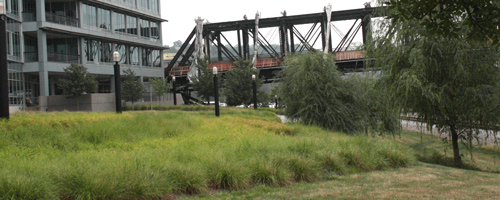
Assessing Brownfield Sustainability:
Life Cycle Analysis and Carbon Footprinting
Ronell Auld, Mike Blackhurst, Natalie French, Chris Hendrickson, Deborah Lange,
Yeganeh Mashayekh, Jeff Miller, Amy Nagengast, Daisy Wang, Kevin Williams, Greg Yuen, Mark Zhuang

Background
Appropriately remediated Brownfields provide an opportunity for sustainable and equitable development in nearly all communities. While Brownfield redevelopment is generally recognized as promoting sustainability, methods and estimates for quantifying life cycle impacts, especially climate change mitigation associated with Brownfield development, do not currently exist. This project will develop methodology and tools that stakeholders can use to both prioritize site development in the community and assess the sustainability of a targeted Brownfield development. For this project, the Brownfields and Green Design Institutes of Carnegie Mellon have teamed with the Pennsylvania Downtown Center (PDC). PDC manages the statewide Main Street and Elm Street programs, and provides the initial target audience (or beneficiaries) of this research. Initially, the focus will be small sites in small communities, but the research will have the ability to be transferable to various regions and economies of scale. PDC’s network of statewide meetings and educational sessions will act as the pivotal link to instruct and assist these local organizations with their small remediation efforts by utilization of these new tools.
Approach
This EPA-funded project has three primary components: training, research, and technical assistance. The training approach is to work with the communities represented by PDC to provide the education necessary to promote Brownfield development and its inherent environmental remedies, economic benefits and quality-of-life improvements. Second, research will be conducted to quantify the life cycle implications of redeveloping brownfields (into neighborhoods) relative to new greenfield development. Based on GDI’s EIO-LCA model and material flows analyses, a life cycle assessment tool will be created to estimate the carbon emissions, pollutant emissions and energy impacts corresponding to such projects. Third, decision-making with respect to site selection can be very complex. Therefore, a site prioritization tool developed at Carnegie Mellon will be further enhanced to help communities prioritize their resources, both time and money, consistent with the needs of the community. The “multi- attribute decision making” tool will also have the ability to weight criteria of local and immediate interest such as environmental and health, ease of development, social and economic considerations, and quality of life indicators to name a few.
Broader Impacts
Pursuit of sustainable Brownfield revitalization in communities will require more than life cycle assessment and site prioritization tools. Only when such tools are coupled with training and additional technical assistance can stakeholders and residents build the knowledge and resources required to bring about change on previously contaminated and underutilized sites. In order to provide empowerment through knowledge, a component of this project will develop a classroom style and computer based training program to educate community decision makers about the strategies of Brownfield revitalization. Technical assistance will be deployed by explaining technical documents, environmental policy, Brownfield procedures, outreach involvement and other basic science to residents and leaders of small communities.
Financial Support
Financial support from the US Environmental Protection Agency (Brownfield Training Research and Technical Assistance Grant) is gratefully acknowledged.
For more information contact:
Deborah Lange
dlange@cmu.edu
(412) 268-7121